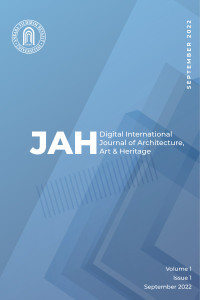3D Architectural Heritage Platform
Architectural Heritage, Digital Cultural Heritage, 3D Modeling, 3D Model Database, Virtual Reality
3D Architectural Heritage Platform
Architectural Heritage, Digital Cultural Heritage, 3D Modeling, 3D Model Database, Virtual Reality,
___
- Abourezq, M., & Idrissi, A. (2016). Database-as-a-service for big data: An overview. International Journal of Advanced Computer Science and Applications, 7(1), 157-177. DOI: 10.14569/IJACSA.2016.070124
- Altuntaş, C., Mert, S., Yaman, G., Cengiz, Y., & Sönmez, M. (2019). Photogrammetric Wireframe and Dense Point Cloud 3D Modelling Of Historical Structures: The Study Of Sultan Selim Mosque and Yusuf Aga Library in Konya, Turkey. In 2ND INTERNATIONAL CONFERENCE OF GEOMATICS AND RESTORATION (GEORES 2019). COPERNICUS GESELLSCHAFT MBH.
- Davoudian, A., Chen, L., & Liu, M. (04 2018). A survey on NoSQL stores. ACM Computing Surveys, 51, 1–43. DOI: 10.1145/3158661 Dhaou, D., Ben Jabra, S., & Zagrouba, E. (2019, June 1). A Review on Anaglyph 3D Image and Video Watermarking. 3D Research. 3D Display Research Center. DOI: 10.1007/s13319-019-0223-1
- Grilli, E., Dininno, D., Petrucci, G., & Remondino, F. (2018). From 2D to 3D supervised segmentation and classification for cultural heritage applications. In ISPRS TC II Mid-term Symposium “Towards Photogrammetry 2020” (Vol. 42, No. 42, pp. 399-406). J Sianandar, J., & Manuaba, I. B. K. (2022, August). Performance Analysis of Hooks Functionality in React and Vue Frameworks. In 2022 International Conference on Information Management and Technology (ICIMTech) (pp. 139-143). IEEE.
- Kunda, D., & Phiri, H. (2017). A comparative study of nosql and relational database. Zambia ICT Journal, 1(1), 1-4. DOI: 10.33260/zictjournal.v1i1.8
- Kuşçuoğlu, G. Ö., & Murat, T. A. Ş. (2017). Sürdürülebilir kültürel miras yönetimi. Yalvaç Akademi Dergisi, 2(1), 58-67. Kyriakidis, A., Maniatis, K., & You, E. (2016). The majesty of Vue. js. Packt Publishing.
- Liu, Z. H., Hammerschmidt, B., McMahon, D., Liu, Y., & Chang, H. J. (2016, June). Closing the functional and performance gap between SQL and NoSQL. In Proceedings of the 2016 International Conference on Management of Data (pp. 227-238).
- Li, Z. (2018). NoSQL Databases. In John P. Wilson (Ed.), The Geographic Information Science & Technology Body of Knowledge (2nd Quarter 2018 Edition). DOI: 10.22224/gistbok/2018.2.10
- Miao, K., Li, J., Hong, W., & Chen, M. (2020). A microservice-based big data analysis platform for online educational applications. Scientific Programming, 2020, 1-13. DOI: 10.1155/2020/6929750 Jatana, N., Puri, S., Ahuja, M., Kathuria, I., & Gosain, D. (2012). A survey and comparison of relational and non-relational database. International Journal of Engineering Research & Technology, 1(6), 1-5. Raut, A. B. P. D. (2017). NOSQL database and its comparison with RDBMS. International Journal of Computational Intelligence Research, 13(7), 1645-1651.
- Richards, J., & Niccolucci, F. (2019). The ariadne impact. Budapest: ARIADNEplus Consortium, and Archaeolingua Publishing House.
- Selanik Ay, T., & Kurtdede Fidan, N. (2013). Öğretmen Adaylarının Kültürel Miras Kavramına İlişkin Metaforları. Electronic Turkish Studies, 8(12), 1135-1152. doi: 10.7827/TurkishStudies.5982 Singh, A. (2016). NoSQL: A new horizon in big data. International Journal of Scientific Research in Science, Engineering and Technology, 2(2), 1183-1188.
- Verber, D. High-Performance Computing with Relational Database Management Systems. In Austrian-Slovenian HPC Meeting 2022–ASHPC22 (p. 41). Yastikli, N., Çetin, Z., & Asamaka, E. (2022). The production of line-drawing and 3D modeling of historical Mehmet Ali Bey Fountain with SFM approach. Cultural Heritage and Science, 3(1), 19-24.
- Zhang, F., Sun, G., Zheng, B., & Dong, L. (2021). Design and Implementation of Energy Management System Based on Spring Boot Framework. Information, 12(11), 457. DOI: 10.3390/info12110457
- URL-1. Discover Europe's Digital Cultural Heritage. (n.d.). Retrieved November 3, 2022, from https://www.europeana.eu/en
- URL-2. Adalar Müzesi - Museum of the princes' islands. (n.d.). Retrieved November 3, 2022, from https://www.adalarmuzesi.org/cms/projeler/mimari-mirasveritabani
- URL-3. Köse, S. (2021, December 7). Microservice Mimari’lerde Veritabanı Tasarımı - Devops Türkiye Medium. https://medium.com/devopsturkiye/microservice-mimarilerde-veritaban%C4%B1-tasar%C4%B1m%C4%B1-d58371ec466
- URL-4. Metcalfe, T. (2017, April 6). Ancient Jerusalem Comes Alive in New Virtual-Reality App. livescience.com. https://www.livescience.com/58566-ancient-jerusalem-reconstructed-in-virtual-reality-app.html
- Başlangıç: 2022
- Yayıncı: Ankara Yıldırım Beyazıt Üniversitesi
3D Architectural Heritage Platform
Ali Akif YÖRÜK, Muhammed Abdullah BÜLBÜL, Salah HAJISMAIL
Salah HAJISMAIL, Emanuele MOREZZİ, Çevirmen: Salah HAJISMAIL
Cuban heritage: the architecture of the revolution.
Matteo BARİSONE, Niccolò POZZİ
